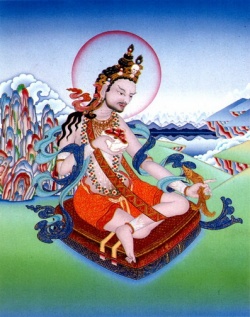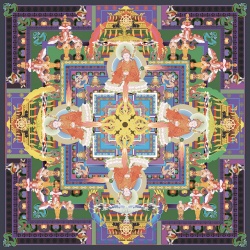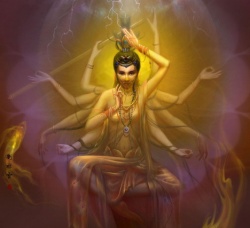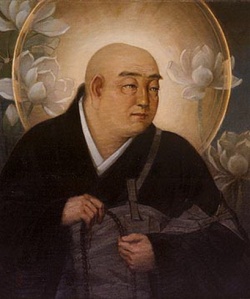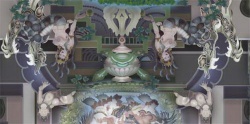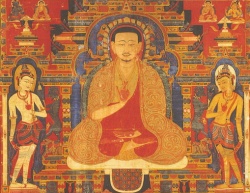Naro Choe Druk
The tradition known in Tibet as the Naro Choe Druk (Tib. Na ro'i chos drug) translates literally as "Naro's Six Doctrines," but has become better known to Western students of Tibetan Buddhism as "the Six Yogas of Naropa." Early scholars such as Dt Evans-Wentz, Prof. Herbert Guenther, and Garma C.C. Chang used this rendition in their translations and consequently established it as standard in the Western Buddhist world. Therefore I have followed their lead in using the term "Six Yogas," rather than "Six Doctrines," both in my earlier work and in the present compendium.
Over the centuries the manner in which the Six Yogas have been taught has varied with the different lines of transmission. Lama Jey Tsongkhapa discusses this in some depth in his longer commentary. There are also traditions of speaking of two, three, four, six, eight, and ten yogas of Naropa. However, these variations are merely different ways of dividing up the pie of the Naropa yogas; there are no substantial differences in what is taught.
To accommodate these differing modes of structuring the Naropa system, in both his longer and shorter treatises Lama Jey Tsongkhapa uses a somewhat complex system of outlines and headings. He does not simply present the six yogas in six chapters, but instead weaves a subtle line of thought that flows through his entire presentation. This makes his two treatises somewhat more difficult to follow than many of the simpler manuals on the system, but accommodates very accurately the flexible nature of the tradition and reflects the arbitrariness of calling it the "Six Yogas."
Later Gelukpa commentaries generally follow Tsongkhapa's lead in this respect. They rarely treat the Six Yogas in six chapters.
THE BACKGROUND AND NATURE OF THE PRACTICE
The Geluk school, which was formed in the early fifteenth century as a fusion of lineages from a dozen earlier sects, received its transmission of the Six Yogas primarily from the Zhalu (Sakya) school. The Zhalu had received it from the Drikung Kargyu (one of the Eight Younger Kargyu schools), which in turn is a derivative of the Pakmo Drupa Kargyu (one of the Four Older Kargyu schools). The Geluk lineage presents the Six Yogas in accordance with the way they were transmitted by Lama Pal Pakmo Drupa, the founder of the Pakmo Drupa school, to Lama Drikung Jigten Sumgon, the founder of the Drikung Kargyu school.
According to Lama Pal Pakmo Drupa's lineage the six yogas are listed as follows: inner heat yoga; illusory body yoga; clear light yoga; the yoga for the transference of consciousness to a higher realm; the yoga for transference of consciousness into another body; and the bardo yoga.
In this arrangement of the six, the inner heat is the foundation of all the yogas; the illusory body and clear light yogas are grouped together as the actual or principal practices for inducing the experience of enlightenment; and the yogas of consciousness transference to a higher realm and transference into another body are auxiliary or branch applications. This accounts for five of the six; the sixth, or bardo yoga, is regarded as both a branch of the illusory body yoga and as a third auxiliary practice.
In other words, the first three yogas-inner heat, illusory body and clear light-are the real methods for accomplishing enlightenment in one lifetime. The last three yogas-consciousness transference to a higher realm, transference into another body, and the bardo yoga- are only required if one fails to accomplish enlightenment before death draws near, and a forceful last-minute method of self-protection is required. The First Panchen Lama puts it as follows in his The Golden Key:
The tradition known in Tibet as the Naro Owe Druk (Tib. Na ro'i chos drug) translates literally as "Naro's Six Doctrines," but has become better known to Western students of Tibetan Buddhism as "the Six Yogas of Naropa." Early scholars such as Dr. Evans-Wentz, Prof. Herbert Guenther, and Garma C.C. Chang used this rendition in their translations and consequently established it as standard in the Western Buddhist world. Therefore I have followed their lead in using the term "Six Yogas," rather than "Six Doctrines," both in my earlier work and in the present compendium. Over the centuries the manner in which the Six Yogas have been taught has varied with the different lines of transmission. Lama Jey Tsongkhapa discusses this in some depth in his longer commentary.
There are also traditions of speaking of two, three, four, six, eight, and ten yogas of Naropa. However, these variations are merely different ways of dividing up the pie of the Naropa yogas; there are no substantial differences in what is taught. To accommodate these differing modes of structuring the Naropa system, in both his longer and shorter treatises Lama Jey Tsongkhapa uses a somewhat complex system of outlines and headings. He does not simply present the six yogas in six chapters, but instead weaves a subtle line of thought that flows through his entire presentation. This makes his two treatises somewhat more difficult to follow than many of the simpler manuals on the system, but
accommodates very 14 Readings on the Six Yogas of Naropa accurately the flexible nature of the tradition and reflects the arbitrariness of calling it the "Six Yogas." Later Gelukpa commentaries generally follow Tsongkhapa's lead in this respect. They rarely treat the Six Yogas in six chapters.
The Geluk school, which was formed in the early fifteenth centurv as a fusion of lineages from a dozen earlier sects, received its transmission of the Six Yogas primarily from the Zhalu (Sakya) school. The Zhalu had received it from the Drikung Kargyu (one of the Eight Younger Kargyu schools), which in turn is a derivative of the Pakmo Drupa Kargyu (one of the Four Older Kargyu schools).
The Geluk lineage presents the Six Yogas in accordance with the way they were transmitted by Lama Pal Pakmo Drupa, the founder of the Pakmo Drupa school, to Lama Drikung Jigten Sumgon, the founder of the Drikung Kargyu school. According to Lama Pal Pakmo Drupa's lineage the six yogas are listed as follows: inner heat yoga; illusory body yoga; clear light yoga: the yoga for the transference of consciousness to a higher realm; the yoga for transference of consciousness into another body; and the bardo yoga In this arrangement of the six, the inner heat is the foundation of all the yogas; the illusory body and clear light yogas are grouped together as the actual or principal practices for inducing the experience of enlightenment; and the yogas of consciousness transference to a higher realm and transference into another body are auxiliary or branch applications.
This accounts for five of the six; the sixth, or bardo yoga is regarded as both a branch of the illusory body yoga and as a third auxiliary practice. In other words, the first three yogas—inner heat, illusory body and clear light—are the real methods for accomplishing enlightenment in one lifetime. The last three yogas—consciousness transference to a higher realm, transference into another body, and the bardo yoga— are only required if one fails to accomplish enlightenment before death draws near, and a forceful last-minute method of self-protection is required.
The First Panchen Lama puts it as follows in his The Golden Kr- A Profound Guide to the Six Yogas of Naropa: The idea is that if one is not able to accomplish all the practices leading to enlightenment before death comes to destroy one's body-vessel, then in order to fulfill the purposes of oneself and others one engages the yogas of either consciousness transference Translator's Introduction 15 or projection into another body. Alternatively, if one is unable to effect this transference, or if one wishes instead to attempt to accomplish final enlightenment in the bardo, then there is the doctrine of the bardo yogas.
In both his longer and shorter treatises on the Six Yogas system (A Book of Three Inspirations and A Practice Manual on the Six Yogas) Lama Jey Tsongkhapa dedicates special attention to the first of the six, or inner heat yoga, because success in the remaining five depends on the level of proficiency attained in the inner heat practice. As he explains in A Book of Three Inspirations, In general, all systems of highest yoga tantra's completion stage involve the preliminary process of controlling the vital energies flowing through the two side channels, rasana and lalana, and redirecting them into the central channel, avadhuti. This is indispensable.
There are numerous means for accomplishing this, based on the traditions of the Indian mahasiddhas, who drew from the various tantric systems. In this tradition [i.e., the Six Yogas of Naropa the main technique is to arouse the inner heat at the navel chakra, the "wheel of emanation," and then through controlling the life energies by means of the AH-stroke mantric syllable, to draw the subtle life-sustaining energies into the central channel. When these energies enter the central channel the four bliss's are induced, and one cultivates meditation on the basis of these in such a way as to give rise to the innate wisdom of mahamudra....
In this tradition the expression "the inner heat, the foundation stone," is well known. This is because in the completion stage yogas one uses the inner heat technology from the very beginning in order to collect the subtle life-sustaining energies into the central channel and thereby arouse the innate great bliss. This is the actual basis upon which all practices rely and upon which all later completion stage yogas are founded.
The inner heat doctrine establishes this basis. The practice of the inner heat doctrine entails directing the life sustaining energies into the central channel. Here the energies enter, abide, and are dissolved. When one trains well in this technique, the strength of the experience has the power to give control over loss of the bodhimind substance [i.e., the sexual drops].
Then, based on this power, one can rely upon a karmamudra as a conducive condition to arouse the four blisses. On this foundation, innate bliss is aroused. Arousing this innate bliss is the purpose of the practices of the inner heat yoga and karmamudra. One unites the innate bliss with meditation upon emptiness, and during the waking state applies oneself to the illusory body doctrine. Based on the experience of the illusory body practice one can engage in the clear light techniques.
Then when asleep at night one can cultivate awareness of the illusory nature of dreams. To do so effectively one must first master the yoga of retaining the clear light of sleep [i.e., the clear light that arises at the moment of falling asleep], and then enter into the dream state from that perspective. If the power to retain the clear light of sleep is accomplished by means of gaining control over the vital energies, this means that during the time of waking practice one must have mastered this control and cultivated the ability to direct the energies into the central channel. Thus the foundation stone of both practices (sleep and dream yogas) is the inner heat doctrine. Only when progress in dream yoga has been made firm can one effectively work with the bardo yogas.
Thus here again [with the bardo yogas) the foundation stone is the power achieved through the inner heat.... As for the yogas of special consciousness transference and forceful projection, as a preliminary to them one must cultivate the ability to draw the life-sustaining energies into the central channel. Therefore in these two the inner heat yoga again is the foundation stone. Thus the inner heat yoga is the basis for success in the remaining five yogas.
For this reason Tsongkhapa and most later Gelukpa commentators made the elucidation of this yoga their prime concern. In recent centuries most treatises written by the Tibetan lamas of the twelve Kargyu schools drop out the fifth yoga—that of forceful projection into another body—because the Naropa lineage of this yoga allegedly was lost with the death of Marpa's son Darma Dodey.
They make up the list of six by separating dream yoga from the illusory body yogas and treat it by itself. Tsongkhapa, however, like Pal Pakmo Drupa, taught dream voga as one of the three stages of the illusory body training, and this tradition has continued in Gelukpa commentarial literature. He provides a detailed account of the forceful projection yoga in A Book of Three Inspirations, but in A Practice Manual on the Six Yogas he simply mentions the yoga by name and does not elucidate the practice, presumably because he considers it beyond the abilities and concerns of most people. This having been said, it is important to remember that, even though the Naropa lineage of the forceful projection yoga may perhaps have died out (and even this theory is questionable), the source of the technique is The [[Chaturpita[Tantra]], which, together with its oral transmission, still survives.
